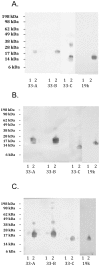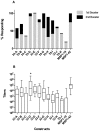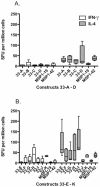T cell epitope regions of the P. falciparum MSP1-33 critically influence immune responses and in vitro efficacy of MSP1-42 vaccines
- PMID: 21931852
- PMCID: PMC3172285
- DOI: 10.1371/journal.pone.0024782
T cell epitope regions of the P. falciparum MSP1-33 critically influence immune responses and in vitro efficacy of MSP1-42 vaccines
Abstract
The C-terminal 42 kDa fragments of the P. falciparum Merozoite Surface Protein 1, MSP1-42 is a leading malaria vaccine candidate. MSP1-33, the N-terminal processed fragment of MSP1-42, is rich in T cell epitopes and it is hypothesized that they enhance antibody response toward MSP1-19. Here, we gave in vivo evidence that T cell epitope regions of MSP1-33 provide functional help in inducing anti-MSP1-19 antibodies. Eleven truncated MSP1-33 segments were expressed in tandem with MSP1-19, and immunogenicity was evaluated in Swiss Webster mice and New Zealand White rabbits. Analyses of anti-MSP1-19 antibody responses revealed striking differences in these segments' helper function despite that they all possess T cell epitopes. Only a few fragments induced a generalized response (100%) in outbred mice. These were comparable to or surpassed the responses observed with the full length MSP1-42. In rabbits, only a subset of truncated antigens induced potent parasite growth inhibitory antibodies. Notably, two constructs were more efficacious than MSP1-42, with one containing only conserved T cell epitopes. Moreover, another T cell epitope region induced high titers of non-inhibitory antibodies and they interfered with the inhibitory activities of anti-MSP1-42 antibodies. In mice, this region also induced a skewed TH2 cellular response. This is the first demonstration that T cell epitope regions of MSP1-33 positively or negatively influenced antibody responses. Differential recognition of these regions by humans may play critical roles in vaccine induced and/or natural immunity to MSP1-42. This study provides the rational basis to re-engineer more efficacious MSP1-42 vaccines by selective inclusion and exclusion of MSP1-33 specific T cell epitopes.
Conflict of interest statement
Figures






Similar articles
-
Antibody and T cell responses in reciprocal prime-boost studies with full-length and truncated merozoite surface protein 1-42 vaccines.PLoS One. 2013 Sep 30;8(9):e75939. doi: 10.1371/journal.pone.0075939. eCollection 2013. PLoS One. 2013. PMID: 24098747 Free PMC article.
-
Malaria parasite-inhibitory antibody epitopes on Plasmodium falciparum merozoite surface protein-1(19) mapped by TROSY NMR.Mol Biochem Parasitol. 2004 Nov;138(1):29-36. doi: 10.1016/j.molbiopara.2004.06.014. Mol Biochem Parasitol. 2004. PMID: 15500913
-
Plasmodium falciparum anti-MSP1-19 antibodies induced by MSP1-42 and MSP1-19 based vaccines differed in specificity and parasite growth inhibition in terms of recognition of conserved versus variant epitopes.Vaccine. 2007 Jan 15;25(5):948-56. doi: 10.1016/j.vaccine.2006.08.041. Epub 2006 Sep 18. Vaccine. 2007. PMID: 17023096
-
Immunogenicity of the C-terminal 19-kDa fragment of the Plasmodium falciparum merozoite surface protein 1 (MSP1), YMSP1(19) expressed in S. cerevisiae.J Immunol. 1994 Sep 15;153(6):2544-53. J Immunol. 1994. PMID: 8077664
-
Antigenicity and immunogenicity of the N-terminal 33-kDa processing fragment of the Plasmodium falciparum merozoite surface protein 1, MSP1: implications for vaccine development.Vaccine. 2007 Jan 5;25(3):490-9. doi: 10.1016/j.vaccine.2006.07.053. Epub 2006 Aug 10. Vaccine. 2007. PMID: 16949181
Cited by
-
Impact of pre-existing MSP1(42)-allele specific immunity on potency of an erythrocytic Plasmodium falciparum vaccine.Malar J. 2012 Sep 7;11:315. doi: 10.1186/1475-2875-11-315. Malar J. 2012. PMID: 22958482 Free PMC article.
-
Orientation of Antigen Display on Self-Assembling Protein Nanoparticles Influences Immunogenicity.Vaccines (Basel). 2021 Jan 29;9(2):103. doi: 10.3390/vaccines9020103. Vaccines (Basel). 2021. PMID: 33572803 Free PMC article.
-
Antibody and T cell responses in reciprocal prime-boost studies with full-length and truncated merozoite surface protein 1-42 vaccines.PLoS One. 2013 Sep 30;8(9):e75939. doi: 10.1371/journal.pone.0075939. eCollection 2013. PLoS One. 2013. PMID: 24098747 Free PMC article.
-
Longevity of Genotype-Specific Immune Responses to Plasmodium falciparum Merozoite Surface Protein 1 in Kenyan Children from Regions of Different Malaria Transmission Intensity.Am J Trop Med Hyg. 2016 Sep 7;95(3):580-7. doi: 10.4269/ajtmh.15-0710. Epub 2016 Aug 1. Am J Trop Med Hyg. 2016. PMID: 27481054 Free PMC article.
-
Evaluation of the immunogenicity and vaccine potential of recombinant Plasmodium falciparum merozoite surface protein 8.Infect Immun. 2012 Jul;80(7):2473-84. doi: 10.1128/IAI.00211-12. Epub 2012 May 14. Infect Immun. 2012. PMID: 22585960 Free PMC article.
References
-
- Holder AA, Guevara Patino JA, Uthaipibull C, Syed SE, Ling IT, et al. Merozoite surface protein 1, immune evasion, and vaccines against asexual blood stage malaria. Parassitologia. 1999;41:409–414. - PubMed
-
- Holder AA, Lockyer MJ, Odink KG, Sandhu JS, Riveros-Moreno V, et al. Primary structure of the precursor to the three major surface antigens of Plasmodium falciparum merozoites. Nature. 1985;317:270–273. - PubMed
-
- Blackman MJ, Ling IT, Nicholls SC, Holder AA. Proteolytic processing of the Plasmodium falciparum merozoite surface protein-1 produces a membrane-bound fragment containing two epidermal growth factor-like domains. Mol Biochem Parasitol. 1991;49:29–33. - PubMed
-
- al-Yaman F, Genton B, Kramer KJ, Chang SP, Hui GS, et al. Assessment of the role of naturally acquired antibody levels to Plasmodium falciparum merozoite surface protein-1 in protecting Papua New Guinean children from malaria morbidity. Am J Trop Med Hyg. 1996;54:443–448. - PubMed
Publication types
MeSH terms
Substances
Grants and funding
LinkOut - more resources
Full Text Sources
Other Literature Sources
Research Materials

